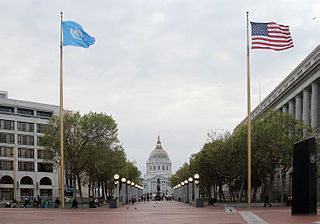
Alameda is a city in Alameda County, California, United States, located in the East Bay region of the Bay Area. The city is primarily located on Alameda Island, but also spans Bay Farm Island and Coast Guard Island, as well as a few other smaller islands in San Francisco Bay. As of the 2020 census, the city's population was 78,280.

The Museum of Modern Art (MoMA) is an art museum located in Midtown Manhattan, New York City, on 53rd Street between Fifth and Sixth Avenues.

Phyllis Ada Diller was an American stand-up comedian, actress, author, musician, and visual artist, best known for her eccentric stage persona, self-deprecating humor, wild hair and clothes, and exaggerated, cackling laugh.

The Civic Center in San Francisco, California, is an area located a few blocks north of the intersection of Market Street and Van Ness Avenue that contains many of the city's largest government and cultural institutions. It has two large plazas and a number of buildings in classical architectural style. The Bill Graham Civic Auditorium, the United Nations Charter was signed in the Veterans Building's Herbst Theatre in 1945, leading to the creation of the United Nations. It is also where the 1951 Treaty of San Francisco was signed. The San Francisco Civic Center was designated a National Historic Landmark in 1987 and listed in the National Register of Historic Places on October 10, 1978.

The Jewish Museum Berlin was opened in 2001 and is the largest Jewish museum in Europe. On 3,500 square metres of floor space, the museum presents the history of Jews in Germany from the Middle Ages to the present day, with new focuses and new scenography. It consists of three buildings, two of which are new additions specifically built for the museum by architect Daniel Libeskind. German-Jewish history is documented in the collections, the library and the archive, and is reflected in the museum's program of events.

The National Museum of American History: Kenneth E. Behring Center collects, preserves, and displays the heritage of the United States in the areas of social, political, cultural, scientific, and military history. Among the items on display is the original Star-Spangled Banner. The museum is part of the Smithsonian Institution and located on the National Mall at 14th Street and Constitution Avenue NW in Washington, D.C.

The National Museum of Art in Norway, also known simply as the National Museum, shortened NaM is a Norwegian state-owned museum in Oslo. It holds the Norwegian state's public collection of art, architecture, and design objects. The collection totals over 400.000 works, amongst them the first copy of Edvard Munch's The Scream from 1893.

Arthur Upham Pope was an American scholar, art historian, and architecture historian. He was an expert on historical Persian art, and he was the editor of the Survey of Persian Art (1939). Pope was also a university professor of philosophy and aesthetics, an archaeologist, photographer, museum director, interior designer, and the co-founder of an international scholarly organization.


ONE National Gay and Lesbian Archives at the University of Southern California Libraries is the oldest existing lesbian, gay, bisexual, and transgender (LGBT) organization in the United States and one of the largest repositories of LGBT materials in the world. Located in Los Angeles, California, ONE Archives has been a part of the University of Southern California Libraries since 2010. ONE Archives' collections contain over two million items including periodicals; books; film, video and audio recordings; photographs; artworks; ephemera, such as clothing, costumes, and buttons; organizational records; and personal papers. ONE Archives also operates a small gallery and museum space devoted to LGBT art and history in West Hollywood, California. Use of the collections is free during regular business hours.


The Arts District is a neighborhood on the eastern edge of Downtown Los Angeles, California in the United States. The city community planning boundaries are Alameda Street on the west which blends into Little Tokyo, First Street on the north, the Los Angeles River to the east, and Violet Street on the south. Largely composed of industrial buildings dating from the early 20th century, the area has recently been revitalized, and its street scene slowly developed in the early 21st century. New art galleries have increased recognition of the area amidst the downtown, which is known for its art museums.

Roger Brown was an American artist and painter. Often associated with the Chicago Imagist groups, he was internationally known for his distinctive painting style and shrewd social commentaries on politics, religion, and art.

The African American Museum and Library at Oakland (AAMLO) is a museum and non-circulating library dedicated to preserving African American history, experiences and culture on 14th Street in Downtown Oakland. It contains an extensive archival collection of such artifacts as diaries, correspondence, photos, and periodicals.
The Berkeley Art Museum and Pacific Film Archive are a combined art museum, repertory movie theater, and archive associated with the University of California, Berkeley. Lawrence Rinder was Director from 2008, succeeded by Julie Rodrigues Widholm in August, 2020. The museum is a member of the North American Reciprocal Museums program.

The GLBT Historical Society maintains an extensive collection of archival materials, artifacts and graphic arts relating to the history of LGBT people in the United States, with a focus on the LGBT communities of San Francisco and Northern California.

Smithsonian Libraries and Archives is an institutional archives and library system comprising 21 branch libraries serving the various Smithsonian Institution museums and research centers. The Libraries and Archives serve Smithsonian Institution staff as well as the scholarly community and general public with information and reference support. Its collections number nearly 3 million volumes including 50,000 rare books and manuscripts.
The following is a timeline of the history of the city of Oakland, Alameda County, California, United States.
Phyllis Green is an artist whose practice involves sculpture, video and installation art. Based in Santa Monica, she has received a Guggenheim Fellowship, as well as grants from the City of Santa Monica, California Community Foundation, Durfee Foundation, Pollock-Krasner Foundation, California Arts Council, National Endowment for the Arts, Canada Council and British Columbia Cultural Fund. In 1996, she was among the first to be awarded a C.O.L.A. grant by the City of Los Angeles. In 2000, she was appointed to the Santa Monica Arts Commission, serving, as its chair from 2004 to 2006. She is married to the photographer Ave Pildas.
The California Historical Radio Society (CHRS) is a non-profit organization centered on the history of radio and radio broadcasting, including related technologies such as vintage TV, amateur radio and HiFi. The focus is on the history of early radio and early radio broadcasting in California, especially the San Francisco Bay Area and the western states. Its museum and headquarters, known as "Radio Central," are located on its new site in Alameda, California.
















